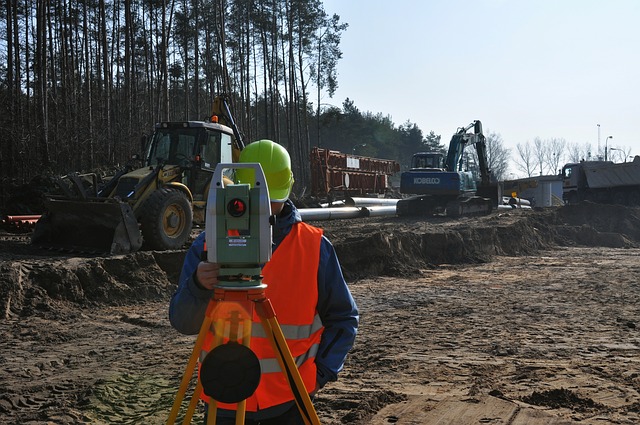Levelling in surveying
Contents |
[edit] What is levelling?
Levelling in surveying is the process of determining the height of one level relative to another. It is used to establish the elevation of a point relative to a datum, or to establish a point at a given elevation relative to a datum. This can be important when laying out or measuring buildings, other built assets and landscape.
For more information see: Levelling applications
[edit] What area the types of levelling instrument?
The main instruments used for levelling include:
- Dumpy level: Often a generic term for an optical level.
- Tilting level: Replaced by the automatic level but useful where vibration is a problem.
- Automatic level: Includes an internal pendulum which allows a horizontal reading.
- Laser level.
- Digital level: Staff read automatically.
- Water level: Useful in confined spaces.
For more information see: Surveying instruments.
[edit] How to take levels
The reticule is sometimes known as the cross-hairs or stadia hairs. The full horizontal line is the reference line for levelling and the 2 shorter lines above and below the full line are stadia lines for tacheometric measurements.
Care should be taken of staffs as well as levels as they are prone to damage. They should be inspected regularly for signs of wear. A common error is misreading the staff, so it is important that time is taken to ensure accurate readings.
The staff must be held vertical. The best ways to eliminate error are as follows:
- A small spirit level should be attached.
- Whilst standing upright the staff should be held in front with both hands down the side of the staff.
- The staff should be ‘rocked’ back and forth, and the lowest reading recorded.
- The verticality of the staff should be checked against a vertical line by standing to the side of the staff and checking it is aligned.
[edit] Booking observations
The steps to take when booking observations are as follows:
- A new job should be started on a new page of the levelling book.
- The details should be entered at the top of the page.
- All observations should be booked legibly. If a mistake is made it should be crossed out and the correct value written above it instead of overwriting figures.
- One line should be used for each position of the staff.
- There should always be an entry made in the remarks column.
- Work should be spread out appropriately.
There are two accepted methods for booking observations:
- Rise and Fall method
- Height of the Plane of Collimation method (HPC/HOC).
Neither method can be said to be more accurate than the other. Rise and Fall does have an additional check on the arithmetical reduction of the observations which makes it more popular on line levelling. The HPC method is used for setting out because one always needs to know the height of the instrument.
[edit] Related articles on Designing Buildings
Featured articles and news
The context, schemes, standards, roles and relevance of the Building Safety Act.
Retrofit 25 – What's Stopping Us?
Exhibition Opens at The Building Centre.
Types of work to existing buildings
A simple circular economy wiki breakdown with further links.
A threat to the creativity that makes London special.
How can digital twins boost profitability within construction?
The smart construction dashboard, as-built data and site changes forming an accurate digital twin.
Unlocking surplus public defence land and more to speed up the delivery of housing.
The Planning and Infrastructure Bill
An outline of the bill with a mix of reactions on potential impacts from IHBC, CIEEM, CIC, ACE and EIC.
Farnborough College Unveils its Half-house for Sustainable Construction Training.
Spring Statement 2025 with reactions from industry
Confirming previously announced funding, and welfare changes amid adjusted growth forecast.
Scottish Government responds to Grenfell report
As fund for unsafe cladding assessments is launched.
CLC and BSR process map for HRB approvals
One of the initial outputs of their weekly BSR meetings.
Architects Academy at an insulation manufacturing facility
Programme of technical engagement for aspiring designers.
Building Safety Levy technical consultation response
Details of the planned levy now due in 2026.
Great British Energy install solar on school and NHS sites
200 schools and 200 NHS sites to get solar systems, as first project of the newly formed government initiative.
600 million for 60,000 more skilled construction workers
Announced by Treasury ahead of the Spring Statement.
The restoration of the novelist’s birthplace in Eastwood.
Life Critical Fire Safety External Wall System LCFS EWS
Breaking down what is meant by this now often used term.
PAC report on the Remediation of Dangerous Cladding
Recommendations on workforce, transparency, support, insurance, funding, fraud and mismanagement.
New towns, expanded settlements and housing delivery
Modular inquiry asks if new towns and expanded settlements are an effective means of delivering housing.



























Comments
[edit] To make a comment about this article, click 'Add a comment' above. Separate your comments from any existing comments by inserting a horizontal line.
Levelling is usually performed with an automatic level and graduated staff rather than the total station in the picture.
This is a wiki site - so if you are unhappy with something, just click 'Edit this article' at the top of the page and change it.